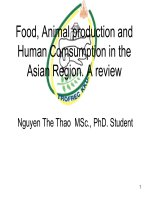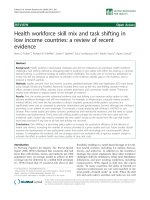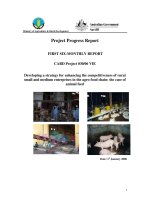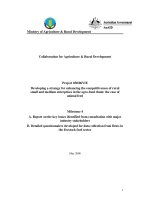Food, Animal production and Human Comsumption in the Asian Region
Bạn đang xem bản rút gọn của tài liệu. Xem và tải ngay bản đầy đủ của tài liệu tại đây (2.61 MB, 51 trang )
Food, Animal production and
Human Comsumption in the
Asian Region. A review
Nguyen The Thao MSc., PhD. Student
1
Introduction
The world problems:
– Population
Present: 6.7 billion
Year of 2025: 9.5billion
– Land limited: agriculture, building,
infrastructure, climate change…,
Food demands v.s Food production
“How the world will sufficiently accommodate
and feed its human population with out
destroying the enviroment and depleting natural
resources???”
2
3
Land used by region and country group,
1961,1991 and 2007, (FAO, 2009)
4
Food security
The World Food Summit (1996): “When all
people at all times have access to
sufficient, safe, nutritious food to maintain
a healthy and active life”
People’s dietary meet and food preferences
- Physical
- Economic
5
Food security based on:
• Food availability: sufficient quantities
• Food access: obtain nutritious diet
• Food use: knowledge of basic nutrition,
care; adequate water and sanition
6
Undernourished people by region (million)
(FAO, 2009)
7
Food emergency in the world (FAO, 2009)
8
The role of agriculture in
food security
• Agriculture products are human food
• Agri. Products provide materials to another
sector
• Remains largest employment sector
• International agriculture are crucial to
country’s food security
“How OUR LIFE is….
….If without AGRICULTURE???”
9
10
11
Human consumption
• Consumption of livestock products has
increased rapidly
• Grown in consumption of livestock
products per capital has markedly
outpaced that of other major food groups
• Since 1960s,
- Milk: almost double
- Meat: more than triple
- Egg: fivefold
12
Consumption of agriculture products (1961-2005),
FAO, 2009
13
Intake of energy deriver from livestock products
per capital 1961-2005. FAO, 2009
14
Per capita consumption of livestock products
by region, country group and country 1980 and
2005. FAO (2009)
15
Meat consumption and share of net imports in
consumption, least-developed countries,
1961–2005. FAO 2009
16
Meat consumption by region, 2000 and 2050
(projected). Rosegrant and Thornton, 2008.
17
Livestock in reducing poverty
• Livestock contribute 40% of global value
of agriculture out put.
• Support livelihood and food security of
almost a billion people
• One of the fastest growing parts in
agricultural economy
opportunities for agriculture development,
poverty reduction and food security gains
18
Roles of livestock
600 m poor people rely on livestock for
livelihoods
Half of these 600m livestock keepers live in
Asia
Also, many millions off-farm jobs created
along the supply chain (trading, processing,
retailing)
Between 4-17 off-farm jobs created for
every 100 litres milk collected, processed,
sold each day.
19
Role of livestock
•
Livestock’s
critical role in
nutrition
Milk and /or meat
important for school
children to improve
learning ability
20
Villages livestock
Output
Input
Rice bran, broken
rice Left over
grains, left over
foods, weeds
Rice bran, broken rice
Crop stems, crop wastes
Weeds, marginal land
Rice straw, corn stalk
Other crop wastes trees,
marginal land
Poultry
(Chicken, Duck &
Turkey)
Pig and small
ruminant
(Pigs, Goat & Sheep)
Large ruminants
( Cattle, Buffalo)
A: Economic: Serve as a current
bank account, sale for small
B: Social: Fighting, fancy
animals cash for daily needs
A: Economic: Serve as semi
annual account, sale for Payments
such as books, clothing, school fees
B: Social: Religious ceremonies
A: Serve as long term account sale
for large expenses such as buying a
tractor, children Marriage or other
essentials
B: Social: Religious ceremonies,
Racing, bull fighting
21
22
Percentage of rural household owning livestock, share of income from
livestock and number of livestock per household
23
Percentage of rural households owning livestock,
by expenditure quintile. (FAO, 2009)
24
Share of income from livestock activity in rural
households, by expenditurequintile (FAO,2009)
25









